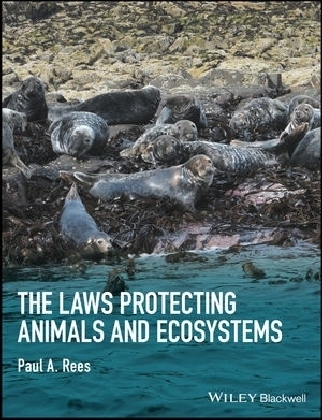
The Laws Protecting Animals and Ecosystems
Wiley-Blackwell (Verlag)
978-1-118-87645-9 (ISBN)
This foundational text supports those studying animal and ecosystem law by providing an overview of the basic legal principles, national and international laws, terminology, the legal mechanisms used to protect animals and ecosystems, and a compendium of the major animal welfare and conservation laws in major English speaking countries. Dr. Rees has been teaching wildlife law for 20 years and ecology for over 35 years and is ideally placed to write this book.
PAUL A. REES is a Senior Lecturer in the School of Environmental and Life Sciences at the University of Salford, UK. His teaching and research interests include the behaviour and welfare of animals in zoos (especially elephants), particularly the importance of policy and legislation in influencing the pivotal role of zoos in the conservation of biodiversity and the welfare of animals living in zoos. He is the author of Urban Environments and Wildlife Law: A manual for Sustainable Development (Blackwell, 2002), An Introduction to Zoo Biology and Management (Wiley- Blackwell, 2011), A Dictionary of Zoo Biology and Animal Management (Wiley-Blackwell, 2013) and Studying Captive Animals (Wiley-Blackwell, 2015).
About the author 8
What is this book for? 9
Acknowledgements 10
Explanatory notes 11
The meaning of some terms used in the law 12
A note on sex 13
Abbreviations and Acronyms
Glossary
Introduction 14
PART I – Legal principles and concepts15
Chapter 1 Legal systems; national, European and international
1.1 Legal jurisdictions 15
1.2 National laws 15
1.2.1 What is national law? 15
1.2.2 The process of enacting new national laws 16
1.2.3 Delegated legislation 17
1.2.4 Looking for national laws 19
1.2.5 Federal systems of law 19
1.3 The European Union and European law 19
1.3.1 Principles 19
1.3.2 Institutions 20
1.3.3 EU Primary legislation 21
1.3.4 EU Secondary legislation 21
1.3.5 The role of the European Court of Justice (ECJ) 23
1.4 International law 24
1.4.1 Sources of international law 24
1.4.2 Principles 24
1.4.3 Titles 25
1.4.4 How a treaty is formed 25
1.4.5 Structure of international treaties 26
1.4.6 Soft law 33
1.4.7 Memoranda of understanding 36
1.4.8 International institutions 36
1.5 Case law and law reports 38
1.5.1 How are legal cases named? 39
1.6 Amending the law 40
1.7 Where to find the law 41
1.7.1 Legal encyclopaedias and websites 41
1.7.2 Where to find UK laws 42
1.7. 3 Where to find US laws 42
1.8 Reading legislation 43
1.9 Legal journals 45
2. Legal principles46
2.1 Legal personality, locus standi and ultra vires 46
2.1.1 Legal personality 46
2.1.2 Locus standi and pressure groups 46
2.1.3 Judicial review and ultra vires 48
2.2 Ethics, precaution, equity, and presumptions of guilt 48
2.2.1 Environmental ethics and animal rights 48
2.2.2 Intrinsic value 51
2.2.3 Precautionary principle 52
2.2.4 Rights of future generations: inter-generational equity 54
2.2.5 Strict liability and the burden of proof in wildlife offences 55
Chapter 3 Beliefs, ethics and history58
3.1 Totems, creation myths and fadies – the protection of animals and ecosystems by ancient beliefs 58
3.2 Ancient beliefs as a threat to wildlife 60
3.3 Animals and religion 61
3.4 A short and incomplete history of the laws protecting animals, plants and ecosystems 62
Chapter 4 Ownership of, and responsibility for, animals and access to wild places68
4.1 Who owns wildlife? 68
4.2 Theft of wildlife 72
4.3 Who is the keeper of an animal? 72
4.4 Liability for the action of animals. 73
4.5 Rights of access to open land and water 75
Chapter 5 Definitions of different categories of living things78
5.1 Introduction 78
5.2 The binomial system of nomenclature 78
5.3 Definitions of a species? 80
5.4 What’s in a name? Problems with definitions 81
5.5 What is an animal? 82
5.6 What is a plant? 83
5.7 Defining habitat types 84
5.8 Definitions of wildlife and types of organisms 85
5.8.1 Wildlife and nature 85
5.8.2 Wild bird 86
5.8.3 Fishes 87
5.8.4 Game and furbearers 88
5.8.5 Parts, trophies and specimens 90
5.8.6 Alien species and animal and plant pests (weeds) 91
5.8.7 Captive and domestic animals 93
5.8.8 Dangerous animals and species 93
5.8.9 Farm animals and livestock 94
5.8.10 Companion animals, assistance animals and working dogs 95
5.8.11 Case law and definitions 97
PART II Mechanisms and enforcement98
Chapter 6 Legal mechanisms I: the protection of wild animals and plants98
6.1 Introduction 98
6.2 The species approach to wildlife conservation 98
6.2.1 Creating new organisations to protect specific taxa 98
6.2.2 Listing protected species – schedules, appendices and annexes 99
6.2.3 Problems with hybrids 103
6.3 Killing and harassment of animals and plant exploitation 104
6.3.1 Prohibition of taking, killing and capturing wild animals 104
6.3.2 Taking of females and their young 105
6.3.3 Protection from disturbance and harassment 108
6.3.4 Protection of breeding and sheltering places 110
6.3.5 Protection of birds’ eggs 112
6.3.6 Prohibition on picking, uprooting etc. of plants 112
6.3.7 Exemptions and the licensing of otherwise prohibited activities 114
6.4 Regulation of the methods and timing of taking, killing and capturing 116
6.4.1 Regulation of methods 116
6.4.2 Close seasons and emergency orders 125
6.5 Sustainable use of resources – hunting, fishing and bioprospecting 127
6.5.1 Prohibition of the exploration of biological resources 128
6.5.2 Use of resources by indigenous peoples 130
6.5.3 No take zones 135
6.5.4 Exclusive economic zones 136
6.5.5 Restrictions on the size of animals that may be taken 137
6.5.6 Sport hunting 139
Chapter 7 Legal mechanisms II: the protection of habitats and ecosystems145
7.1 Defining ecosystems and habitats 145
7.2 The protection of the Earth’s ecosystem and sites of global importance 145
7.2.1 World Heritage Sites 145
7.2.2 Biosphere reserves 146
7.2.3 Global protection of biodiversity 146
7.2.4 The protection of the global ecosystem: climate change 147
7.2.5 The protection of polar areas 148
7.2.6 Protection of freshwater habitats 149
7.2.7 Protection of marine waters 152
7.2.8 The protection of forests, trees and hedgerows 154
7.3 Protected areas and the protection of migratory routes 159
7.3.1 Privately owned nature reserves 160
7.3.2 The establishment of protected areas 161
7.3.3 Prohibition of certain activities in protected areas and forests 177
7.3.4 Protection of migration routes 181
7.3.5 Powers to acquire land 183
7.3.6 Conservation easements 183
7.3.7 Is there a need for airspace reserves? 184
Chapter 8 Legal mechanisms III: restoration, trade and conflicts186
8.1 The restoration of populations and ecosystems 186
8.1.1 Reintroduction of animals to the wild 186
8.1.2 Recovery plans, action plans and abatement plants 192
8.1.3 Restoration of rare and threatened habitats 194
8.1.4 Role of ex-situ conservation 195
8.1.5 Conservation of biodiversity – duty imposed on government departments etc. 196
8.1.6 Identification of animals bred in captivity 197
8.1.7 Prohibition on the introduction, spreading or release of exotic and pest species 197
8. 2 Restrictions on the trade and exhibition of protected species 201
8.2.1 The historical importance of wildlife as symbols of power and friendship 201
8.2.2 Restrictions on transportation and trade 201
8.2.3 Restriction on the exhibition of rare species 207
8.2.4 EIA in the USA: the National Environmental Policy Act (NEPA) of 1969 208
8.2.5 Product labelling 209
8.3 Problem animals and human-animal conflict 212
8.3.1 Problem animals and food 212
8.3.2 Confining domestic and problem animals 214
8.3.3 Problem animal control 216
8.3.4 Reduction of human-animal conflict 220
Chapter 9 Legal mechanisms IV: planning, knowledge, funding and enforcement222
9.1 Planning policy and nature conservation 222
9.1.1 Requirement for an Environmental Impact Assessment 222
9.1.2 EIA in the European Union 222
9.2 Gathering and disseminating information 224
9.2.1 Identification and monitoring of wildlife 224
9.2.2 Public education and awareness 225
9.2.3 Transfer of knowledge and exchange of information 226
9.2.4 Promoting research 226
9.3 Funding and legislation 227
9.3.1 Transfer of funding between rich and poor states 228
9.3.2 Allocation of government funding for conservation 228
9.3.3 Agricultural payments 230
9.3.4 Fund raising for conservation 231
9.3.5 Tax benefits for conservation 232
9.3.6 Improving legislation and its enforcement 234
Chapter 10 Animal welfare and the law234
10.1 Introduction 235
10.2.1 Defining cruelty 236
10.2.2 The five freedoms 237
10.2.3 Animal cruelty and violence towards humans 238
10.2.4 Provision of veterinary treatment 238
10.3 Animal rights legal cases 240
10.4 Legal mechanisms used to protect and control domestic and captive animals 241
10.4.1 Limitation on, or prohibition of, excessive physical activity and types of restraint 241
10.4.2 Provision of sanctuaries for retired working and laboratory animals 244
10.4.3 Limitation on feeding methods 245
10.4.4 Prohibition of mutilation and other cruel practices 245
10.4.5 Regulation of animal experiments 246
10.4.6 Requirement for owners of animal to provide proper care and accommodation 249
10.4.7 Provision of public education 255
10.4.8 Licensing of premises used for keeping, breeding, boarding, selling and exhibiting animals 255
10.4.9 Control and licensing of domestic animals 260
10.4.10 Prohibition of animal fighting 270
10.4.11 Protection of animals used in entertainment and gambling 272
10.4.12 Regulation of the transportation and movement of animals 277
10.4.13 Control of diseased wild animals 283
10.4.14 Humane and religious slaughter 284
10.4.15 Bestiality 286
Chapter 11 Crime detection and law enforcement287
11.1 Wildlife crime reporting 287
11.2 Wildlife crime forensics 287
11.3 Criminal and civil sanctions 288
11.4 Liability of employers, principals and bodies corporate 289
11.5 Inspectors, animal control officers, water bailiffs and other specialist officers 291
11.5.1 Inspectors and other specialist officers 291
11.5.2 Forest officers 295
11.5.3 Wildlife wardens and rangers 295
11.5.4 Specialist conservation and wildlife police 297
11.5.5 International police and wildlife crime organisations 300
11.5.6 The role of non-governmental organisations in enforcing animal cruelty laws 301
11.5.7 NGOs and enforcement 302
11.5.8 Statutory nature conservation agencies 303
11.6 Penalties 305
11.6.1 Death 305
11.6.2 Imprisonment 306
11.6.3 Fines 307
11.6.4 Ban on keeping animals/ seizure of animals 308
11.6.5 Closure of facilities keeping animals 309
11.6.6 Seizure or forfeiture of firearms, vehicles, equipment and other items 310
11.6.7 Injunction 311
11.6.8 Restoration of ecosystems 311
11.7 The enforcement of international law 313
11.7.1 International Court of Justice (ICJ) and case law 313
11.7.2 International sanctions 314
Part III – Major national, European and international laws which protect animals, plants and ecosystems316
Chapter 12 National laws316
12.1 United Kingdom 316
12.2 United States of America 323
12.3 Canada 325
12.4 Australia 325
Australian state laws 326
12.5 New Zealand 326
12.6 India 327
12.7 Kenya 327
12.8 Nigeria 328
12.9 South Africa 328
12.10 Tanzania 328
12.11 Thailand 328
Chapter 13 European laws328
13.1 Directives and Regulations 329
13.2 EU case law 332
Chapter 14 International laws334
Appendix I 338
Appendix II. A chronology of major legislation affecting animals and nature conservation in the UK 342
Appendix III. A chronology of major legislation affecting animal and nature conservation law in the United States of America 346
References 347
Table of laws and cases 355
Legislation 355
NATIONAL LAWS 355
EUROPEAN LAW 365
INTERNATIONAL LAWS 367
CASE LAW 369
RESOLUTIONS AND NOTIFICATIONS 370
Index 376
| Erscheinungsdatum | 28.11.2017 |
|---|---|
| Verlagsort | Hoboken |
| Sprache | englisch |
| Maße | 191 x 246 mm |
| Gewicht | 1293 g |
| Themenwelt | Naturwissenschaften ► Biologie ► Ökologie / Naturschutz |
| Naturwissenschaften ► Biologie ► Zoologie | |
| Recht / Steuern ► EU / Internationales Recht | |
| Veterinärmedizin ► Allgemein ► Fleischhygiene / Lebensmittelkunde | |
| ISBN-10 | 1-118-87645-8 / 1118876458 |
| ISBN-13 | 978-1-118-87645-9 / 9781118876459 |
| Zustand | Neuware |
| Informationen gemäß Produktsicherheitsverordnung (GPSR) | |
| Haben Sie eine Frage zum Produkt? |
aus dem Bereich


